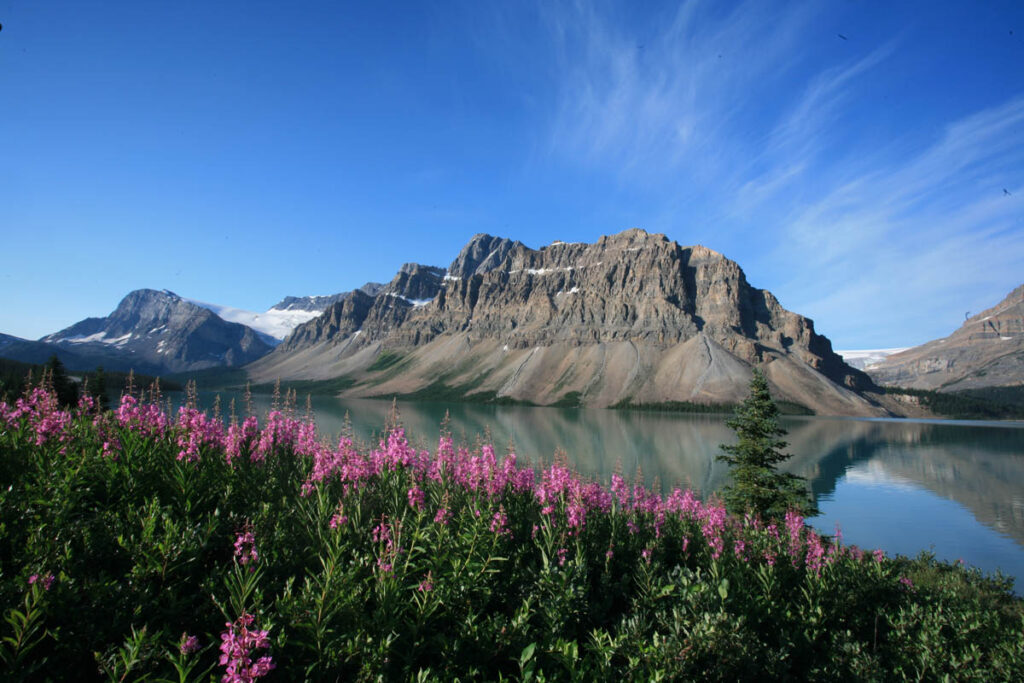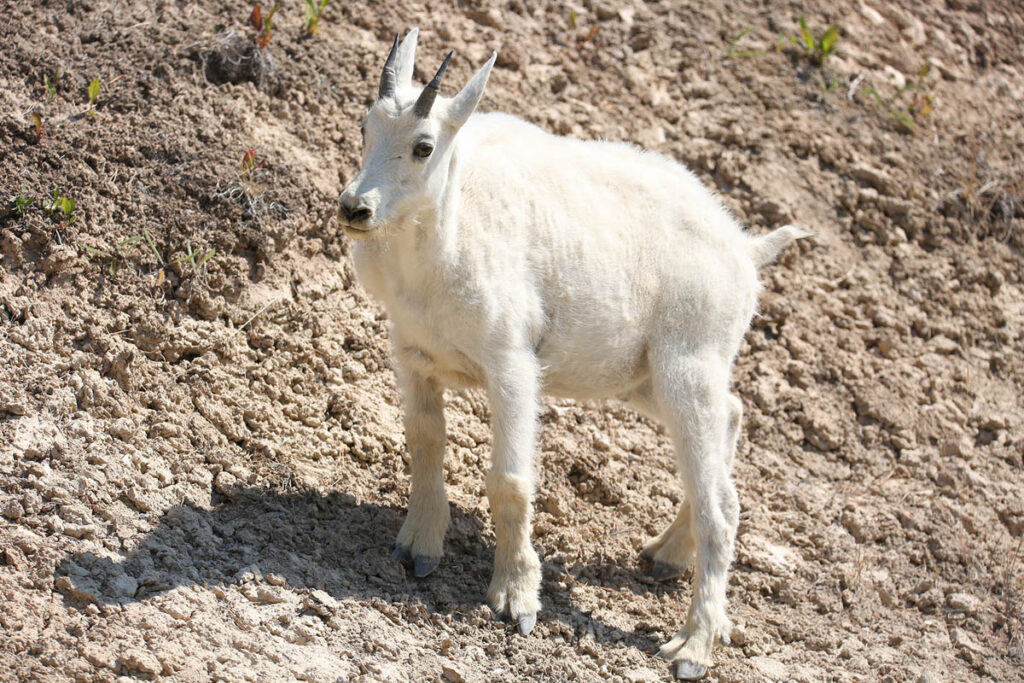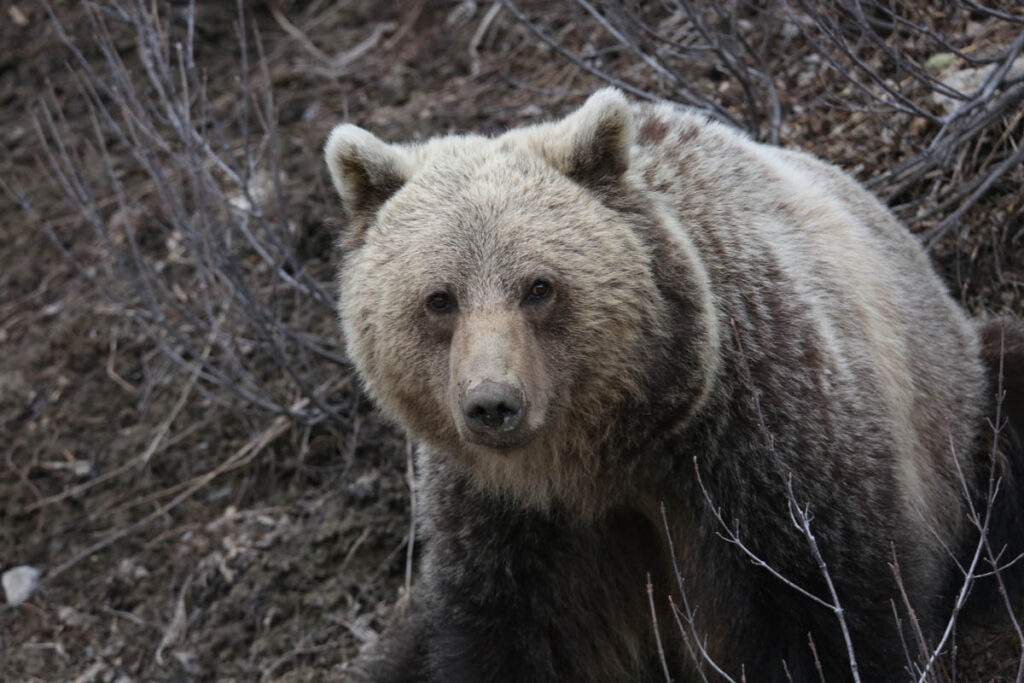Icefields Parkway Nature Guide
The Icefields Parkway Park Nature Guide describes the geology, plants, and animals you will see and experience along the Icefields Parkway between Lake Louise and Jasper.
The Icefields Parkway parallels the Continental Divide (also called the Great Divide) for its entire length. The Continental Divide through the Canadian Rockies is not particularly high relative to elevations in the United States, but these mountains are among the most spectacular along the range’s entire length.
About 100 million years ago, layers of sedimentary rock—laid down here up to a billion years ago—were forced upward, folded, and twisted under tremendous pressure into the mountains seen today. The land’s contours were further altered during four ice ages that began around one million years ago. The last ice age ended about 10,000 years ago, and the vast glaciers began to retreat. A remnant of this final sheet of ice is the huge Columbia Icefield; covering approximately 325 square kilometres (125 square miles) and up to 400 metres (1,300 feet) deep, it’s the most extensive icefield in the Rocky Mountains. As the glaciers retreated, piles of rock melted out and were left behind. Meltwater from the glaciers flowed down the valleys and was dammed up behind the moraines. Maligne Lake, like many other lakes in the park, was created by this process. The glacial silt suspended in the lake’s waters produces amazing emerald, turquoise, and amethyst colours; early artists who painted these lakes had trouble convincing people that their images reflected reality.
In addition to creating the park’s gemlike lakes, the retreating glaciers carved out the valleys that they ever-so-slowly flowed through. North of the Columbia Icefield, the Athabasca River Valley is the region’s largest watershed, a typical example of a U-shaped, glacier-carved valley. The Athabasca River flows north through the valley into the Mackenzie River System and ultimately into the Arctic Ocean.
The glacial silt that paints the lakes a beautiful turquoise colour carried down streams from glaciers, giving lakes and rivers a pale green milky look. Another beautiful aspect of the Icefields Parkway scenery is the abundance of waterfalls, especially on the portion through Jasper National Park, including Tangle, Sunwapta, and Athabasca Falls.
Flora
Elevations along the Icefields Parkway range from 1060 metres (3,480 feet) at the town of Jasper to 2,088 metres (6,800 feet) at Bow Summit, highest point of the route. That makes for a wide range of resident plant life. Only a small part of the Icefields Parkway lies in the montane zone. It is characterized by stands of Douglas fir (at its northern limit) and lodgepole pine, while balsam poplar, white birch, and spruce also occur. Savanna-like grasslands occur on drier sites in valley bottoms. Well-developed stretches of montane can be found along the floors of the Athabasca River Valley and east of Saskatchewan River Crossing on the Kootenay Plains, providing winter habitat for larger mammals such as elk.
The subalpine zone, heavily forested with evergreens, extends from the lower valley slopes up to the tree line at an elevation of around 2,200 metres (7,220 feet). The subalpine occupies around 50 percent of the route. The dominant species in this zone is lodgepole pine, although Engelmann spruce, subalpine fir, poplar, and aspen also grow here. The park’s extensive stands of lodgepole pine are inhabited by few large mammals because the understory is minimal. Wildflowers are common in this zone and can be found by the roadside, in clearings, or on riverbanks.
Timberline here lies at an elevation of 2,050 to 2,400 metres (6,275 to 7,870 feet) above sea level. Above this elevation is the alpine zone, where the climate is severe (the average yearly temperature is below freezing), summer is brief, and only a few stunted trees survive. The zone’s plant species grow low to the ground, with extensive root systems to protect them during high winds and through the deep snow cover of winter. During the short summer, these open slopes and meadows are carpeted with a profusion of flowers such as golden arnicas, bluebells, pale columbines, and red and yellow paintbrushes. Higher still are brightly coloured heather, buttercups, and alpine forget-me-nots.

Fireweed at Bow Lake.
Fauna
Wildlife is abundant along the Icefields Parkway. By May and June, most of the snow cover at lower elevations has melted, the crowds haven’t arrived, and animals can be seen feeding along the edge of the highways. In fall, tourists move to warmer climates, the elk rutting season begins, and bears go into hibernation.
While the Icefields Parkway provides ample opportunities for seeing numerous animals in their natural habitat, it also leads to human-animal encounters that are not always positive. For example, less than 5 percent of the region is made up of well-vegetated valleys. These lower areas are essential to the larger mammals for food and shelter but are also the most heavily traveled by visitors. Game trails used for thousands of years are often bisected by roads, and hundreds of animals are killed each year by speeding motorists. Please drive slowly along the Icefields Parkway.
Campground Critters
Several species of small mammals thrive around campgrounds, thanks to an abundance of humans who are careless with their food. Columbian ground squirrels are bold and will demand scraps of your lunch. Golden-mantled ground squirrels and red squirrels are also common. The least chipmunk (often confused with the golden-mantled ground squirrel thanks to similar stripes) can also be seen in campgrounds; they’ll often scamper across your hiking trail, then sit boldly on a rock waiting for you to pass.
Ungulates
Six species of ungulates inhabit the region, mostly all at lower elevations. The large-eared mule deer is commonly seen grazing along the north end of the Icefields Parkway. White-tailed deer can be seen throughout the region, but are not particularly common.
The town of Jasper is in the home range of about 500 elk, which can be seen most of the year around town or immediately south along the Icefields Parkway. Moose, although not common, can occasionally be seen feeding on aquatic plants along the major drainage systems at lower elevations.
In summer, mountain goats browse in alpine meadows. A good place for goat watching is Goats and Glaciers Lookout near Athabasca Falls. Unlike most of the park’s large mammals, these sure-footed creatures don’t migrate to lower elevations in winter but stay sheltered on rocky crags where wind and sun keep the vegetation snow free. Often confused with the goat is the darker bighorn sheep. The horns on the males of this species are thick and often curl 360 degrees. Bighorns are common in the east of the park at Disaster Point and will often approach cars. An estimated 2,500 bighorn reside in the park.
Jasper has traditionally been home to four small herds of woodland caribou, but at least one (Maligne) has not been sighted for many years and numbers in the others are decreasing rapidly. There is still a stretch of Icefields Parkway between Beauty Creek Hostel and Sunwapta Falls that is signposted as a caribou crossing, but they are very rarely seen here.

Mountain goat.
Bears
Numbering around 100 within Jasper National Park, black bears are widespread and occasionally wander into campgrounds looking for food. They are most commonly seen along the Icefields Parkway in spring when they first come out of hibernation. Grizzly bears are occasionally seen feeding alongside the Icefields Parkway early in summer. For the most part, they remain in remote mountain valleys.

Grizzly bears are common along the Icefields Parkway in spring.
Reclusive Residents
Several of the park’s resident species keep a low profile, usually out of sight of humans. Populations of the shy and elusive lynx fluctuate with that of their primary food source, the snowshoe hare. The largest of the big cats in the park is the cougar (also called the mountain lion), a solitary carnivore that inhabits remote valleys. Jasper’s wolves are one of the park’s success stories. After being driven to near extinction, the species has rebounded. Five packs now roam the park, but they keep to the deep wilderness rarely traveled by people. While not common in the park, coyotes can be seen in cleared areas alongside the roads, usually at dawn and dusk.
Other Mammals
The pine marten is common but shy; look for them in subalpine forests. The short-tailed weasel—a relative of the marten—is also common, while the long-tailed weasel is rare. At higher elevations look for pikas in piles of fallen rock. Hoary marmots live near the upper limits of vegetation growth, where their shrill warning whistles carry across the open meadows; Helen Lake Trail and Bow Summit Trail both support a healthy population of these noisy creatures.
Birds
The extensive tree cover in the lower valleys hides many species of birds, making them seem less abundant than they are; 248 species have been recorded. The two you’re most likely to see are the gray jay and Clark’s nutcracker, which regularly joins picnickers for lunch. Also common are black-and-white magpies, raucous ravens, and several species of ducks, which can be seen around lakes in the Athabasca River Valley.
High alpine slopes are home to white-tailed ptarmigan, a type of grouse that turns white in winter. Also at this elevation are flocks of rosy-finches that live under overhanging cliffs. In subalpine forests, the songs of thrushes and the tapping of woodpeckers can be heard.
